In 300 milliseconds, forward momentum has stopped. Airbags have deployed. Occupants have already been cushioned by them, and started reversing course toward their seats. After colliding with a gray slab of steel, the entire left front-quarter of the Nissan Juke has sheared backward. From the side, its turquoise paint makes it look like a flash-frozen ocean wave.Twice a week researchers here conduct some of the most advanced crash testing of new vehicles in America.
A crew descends upon the wounded Juke and begins cleaning up an assortment of fluids leaking from its underbelly. An acrid smell reminiscent of gunpowder lingers in the air. Shards of plastic and glass are scattered like confetti after a ticker-tape parade.
Twice a week, this is the scene at the Insurance Institute for Highway Safety where, inside a building that resembles an empty warehouse in the middle of dairy country in rural Virginia, researchers conduct some of the most advanced crash testing of new vehicles in America. Of all the crash tests conducted here in the Vehicle Research Center in Ruckersville, the one the Juke underwent last month is perhaps the most important for everyday motorists.
The IIHS calls it the "small-front overlap test," and it's designed to examine how a vehicle handles a collision with a stationary object, like a tree or parked car, that juts into its path and clips the front quarter of the vehicle.
Its name may sound bland and technical, but that belies the true nature of a crash that is perhaps the cruelest that occur on US roads. Despite widespread advances in traffic safety, these sorts of accidents remain an automotive Achilles' heel – many cars are surprisingly inept at handling them. In the real world, small-front overlap crashes account for almost a quarter of frontal crashes that involve a serious injury or death.
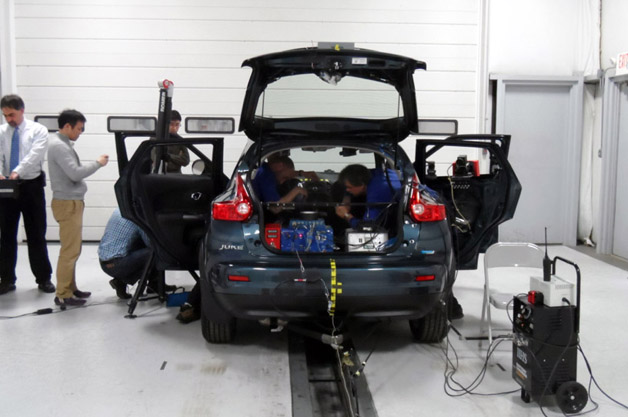
The test is controversial. Several automakers are skeptical of whether it correlates with actual crashes. Car & Driver recently summed up their feelings on the test, calling the small-front overlap nothing more than a "hook on which to hang some good ol' mainstream paranoia." But automakers have nonetheless scrambled to redesign their cars to meet test standards because the overall crash-test rankings produced by the IIHS are often influential with car buyers.Automakers have scrambled to redesign their cars to meet test standards because the rankings produced by the IIHS are influential with car buyers.
Safety advocates, on the other hand, praise the test, which is the newest in the crash-test canon. They believe the test has compelled the auto industry to produce safer cars and left consumers with a clearer understanding of which vehicles still leave them vulnerable in a crash.
"IIHS has done more than any organization to get car buyers to consider safety when they purchase a new car, and to help convince car manufacturers that safety sells," said J. Peter Kissinger, president and CEO of the AAA Foundation for Traffic Safety.
Last month's test of the Juke marked a milestone. It was the 100th car evaluated in the small-front overlap test since its inception in February 2012. To mark the occasion, the IIHS gave us a behind-the-scenes look at the crash test reshaping automotive safety.
Preparing For Impact
On the morning of the test, the crash-test dummy seated in the driver's seat of the Juke gets more attention than the car itself. Seven IIHS employees spend more than two hours positioning, prodding and painting the dummy. Four representatives from Nissan photograph their preparations.
Today, the dummy used is a 15-year crash-test veteran. The dummies are durable. Lab technicians recalibrate them every five tests, and they can last decades. "Though, when we did trailer under-ride tests, we went through a lot of heads, a lot of necks," says Sean O'Malley, senior test coordinator at IIHS.
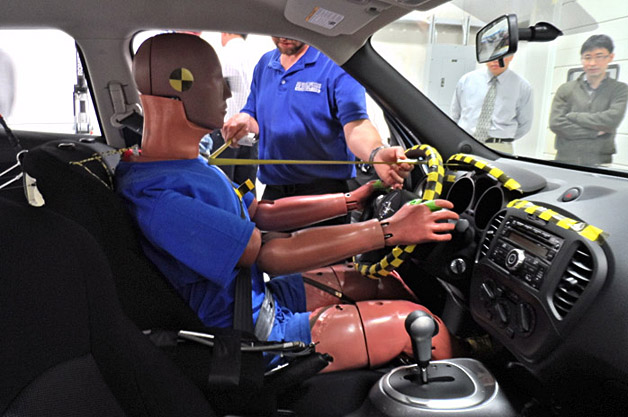
At five-foot-seven, 170 pounds, the dummy represents the size of an average American male – at least, at the time of design. He's examined from every conceivable angle and distance. Seatback angle. Neck-bracket angle. Pelvic angle. Ankle-to-ankle distance. Ribcage-to-steering-wheel distance. Nose-to-ceiling distance.The dummy represents the size of an average American male – at least, at the time of design.
One of the Nissan representatives has a question over how the dummy's foot was placed on the accelerator. An IIHS researcher explains that he gently placed the foot down, as a mother might lay a sleeping infant into a cradle. The foot, he assures everyone, is not pressing the pedal.
It may seem like a picayune detail, but it's a useful conversation for two reasons: It illustrates to everyone in the room just how meticulous the researchers are when it comes to setting up the crash test. It also underscores the inherent tension between the researchers and automakers.
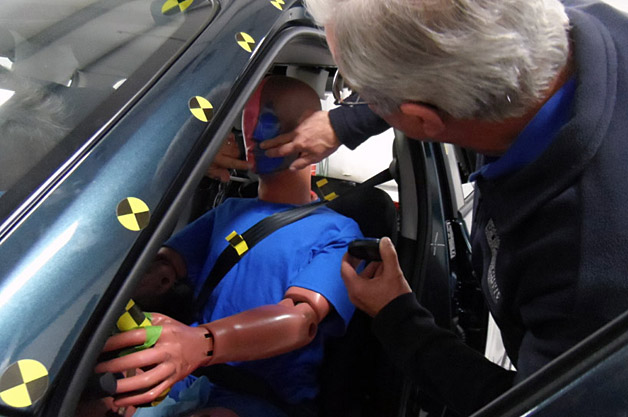
IIHS invites representatives from the car companies to watch the tests and shares its data with them. But ultimately, the manufacturers have no say in the proceedings. And given the high stakes – a third party is evaluating whether their product protects or harms its customers – the Nissan representatives are understandably nervous.Lights illuminate the area where the crash takes place. A Klaxon sounds. A countdown begins..
Onlookers watch from an observation deck located directly above the car's 600-foot path. A Klaxon sounds. A countdown begins.
Shooting The Gap
Small-front overlap crashes play a dirty trick on drivers. Because of both physics and poor design for this sort of scenario, the deadly forces in these accidents often evade the safety systems that are supposed to provide protection.
The deceit starts under the hood. Two energy-absorbing support bumpers bear the brunt of impact in full-frontal crashes. But because they're located inward, the far sides of a car's front are often left defenseless when they're hit.
When an accident occurs at these far sides, forces can bypass the barriers and accordion whatever sheet metal stands in the way. In a poorly designed car, the forces can push the tire rearward and straight into the structural components around the cabin. When these structures crumple, people get hurt.
"What you want to do is direct the crash energy," said Selim Hammoud, director of product safety for Nissan. "You want to absorb the energy and change the force, direct it away from the occupant compartment. That's' where you really achieve the favorable result."
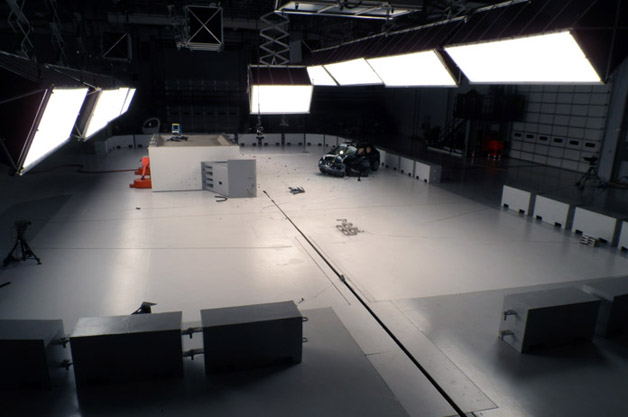
Inside the cabin, the crash can be just as unforgiving.The driver's head can miss both airbags and smack straight into the A-pillar. Researchers at IIHS call this "shooting the gap."
In theory, an airbag deploying from the steering wheel and a side-curtain airbag deploying from the space above the driver's side window should cushion the driver's head. In practice, they often don't do their jobs in a small-front overlap crash. Because the forces in a small-overlap crash come from the far side, they can push the dashboard out of position, and in turn, cause the airbag to veer away from the space it's needed most.
At the same time, side-curtain airbags don't always extend far enough to cover the exposed territory near the window. As a result, the driver's head can miss both airbags and smack straight into the A-pillar of the vehicle. Researchers at IIHS call this "shooting the gap."
Human heads are remarkable in their toughness. They can withstand forces in excess of 70 Gs. But this is the precise point in the small-front overlap accident where many deaths and injuries occur.
Disparity In Results
Car travel has never been safer. Even as the number of Americans driving and the number of vehicle miles traveled have increased over the past 40 years, the number of traffic deaths has fallen from a peak of 54,589 in 1972 to 33,561 in 2012, according to the latest figures from the National Highway Traffic Safety Administration.
Manufacturers are building better vehicles. The across-the-board improvement can be seen in the results from other IIHS crash tests. So many vehicles receive "good" rankings on the roof strength, moderate front overlap, side impact and head-restraint tests, in fact, that it's often hard to differentiate between the best cars and the adequate ones.
The small-front overlap is the exception. There's a big disparity in the results.
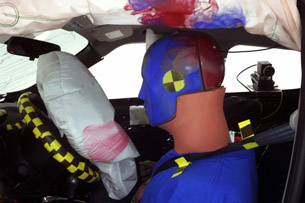
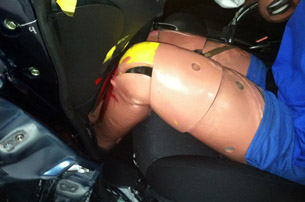
"Over time, all cars will do well in this test, but we're in a transitional period right now where only a small number of vehicles pass," said Karl Brauer, a senior industry analyst at Kelley Blue Book, "and only if they've taken this type of crash energy into account during their latest engineering redesign or refresh."Right now, some of the most popular cars in America get poor scores.
Right now, some of the most popular cars in America get poor scores. The Ford Escape and Toyota RAV4, two of the best-selling small crossovers in the country, both earned "poor" grades on the small-front overlap, the latter failure coming even after Toyota asked for more time to redesign its car. Other cars, like the Subaru Forester, Mitsubishi Outlander Sport and Chevrolet Spark, have withstood the test surprisingly well, earning "good" rankings on the test.
(All the IIHS crash-test results can be found here).
Vehicles must earn a "good" or "acceptable" grade on the small-front overlap – and "good" scores on all the other IIHS tests, among other criteria – in order to claim a Top Safety Pick+ designation, the organization's top overall prize, which can become a significant part of advertising campaigns for the winners.
"The ones that do well start using that in commercials the next day," O'Malley says. "The ones that fail, they say, 'We meet all the federal safety standards.' That's the fallback."
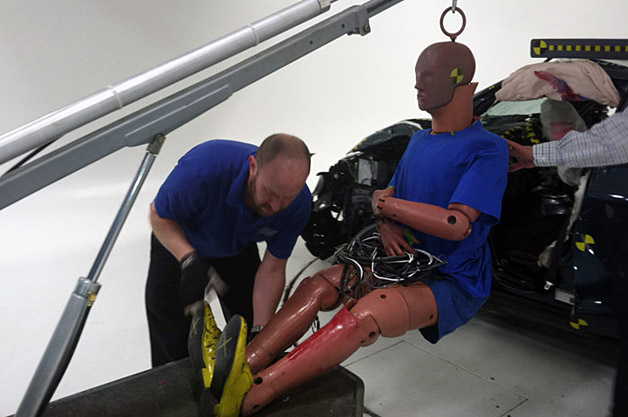
No company has learned the perils or value of the small-front overlap test as much as Nissan. Last spring, the Nissan Rogue, a small crossover, was singled out after a terrible test result. "The structural performance of the Nissan Rogue is one of the worst IIHS engineers have seen," the organization's written report said.The impact sounds like a gunshot. Afterward, witnesses hear a persistent ringing.
One week before the Juke test, Nissan had its redesigned 2014 Rogue re-tested at the Vehicle Research Center. This time, the occupant compartment held firm. The dummy emerged unscathed. And the performance allowed the Rogue to capture a coveted IIHS Top Safety Pick+ recommendation.
The End Result
Seven hundred and fifty thousand watts of light pour onto the spot on the floor where the accident will occur. There's a high-pitched whir as the Juke, hooked to a hydraulic system akin to a horizontal elevator, is pulled toward its destination. Four digital cameras inside the vehicle and three cameras outside snap 500 frames per second.
Seven seconds after it started its journey, the car collides with the steel barrier, spins to the right about 150 degrees, and comes to a rest facing the direction from which it came. Its impact sounds like a gunshot. Afterward, witnesses hear a persistent ringing. "I've learned to plug my ears," O'Malley says.
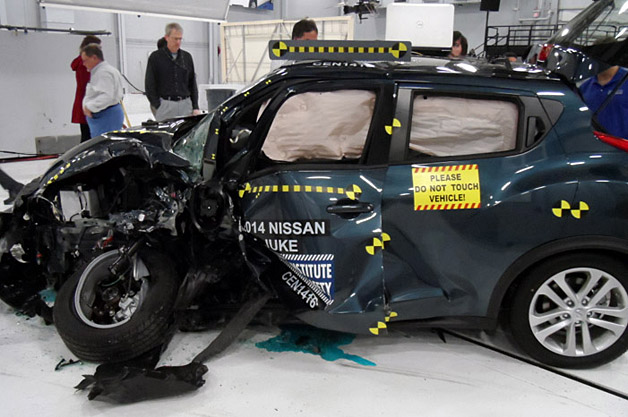
The Juke fared poorly on the test. IIHS cannot share official results or data gathered from its test until its competitors have been tested. Results are due in August. But based on published testing parameters and protocols, the Juke had some obvious deficiencies on this small-front overlap test.It takes several technicians more than an hour, longer than usual, to extricate the dummy.
Its dashboard – and thus, the airbag – shifted several centimeters out of position. The structure around the lower part of the cabin buckled. The dummy's feet aren't entirely trapped, but it takes several technicians more than an hour, longer than usual, to extricate the dummy.
A hook is attached to the dummy's head, and a small crane hoists it out of the car. Alone now, the Juke sits on a turntable in a soft white room. If not for the mangled car sitting upon its stage, it could be mistaken as a photo shoot of the latest new-car offering. The driver's side door is cut off and flung into a pile of old doors in the corner of the room. The autopsy is complete.
Bought brand new from a local dealership by IIHS only a week earlier, the car is now a total loss, like all the others that pass through these doors. Its brief life, a worthy sacrifice in the name of science.
Pete Bigelow is an associate editor at AOL Autos. He can be reached via email at peter.bigelow@teamaol.com and followed on Twitter @PeterCBigelow.










Sign in to post
Please sign in to leave a comment.
Continue